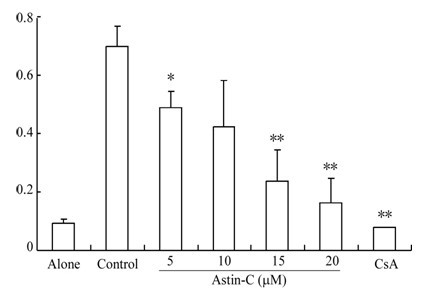Compositae cyclopeptide, immunosuppressive medicine using compositae cyclopeptide as active ingredient and preparation method and application of compositae cyclopeptide
A cyclic peptide and type technology, which is applied in the application field of Compositae type cyclic peptides in the preparation of immunosuppressive drugs, can solve the problems of unfavorable mass production, high price, unfavorable solvent recovery and the like
- Summary
- Abstract
- Description
- Claims
- Application Information
AI Technical Summary
Problems solved by technology
Method used
Image
Examples
Embodiment 1
[0044] Preparation of Compositae-type cyclic peptide compounds Astin C (1), Astin B (2), Astin D (3), Astin H (4), Tataricin A (5) and structure identification of Tataricin A (5):
[0045] Take Aster ( Aster tataricus .L) 50 Kg of dried roots and rhizomes, crushed and soaked in 90% industrial methanol for 5 hours, then heated and refluxed for extraction (temperature = 65°C), extracted three times in total, the first time was 3 hours, the second time was 2 hours, After 2 hours for the third time, the extracts were combined, concentrated under reduced pressure to remove the organic solvent to obtain a total of 23 Kg of methanol extract, and the crude extract was distributed in water, followed by full extraction with ethyl acetate and n-butanol, equal volume Extract three times, recover the solvent to obtain ethyl acetate part (2Kg), n-butanol part (5L) and water part; dissolve the ethyl acetate part with methanol, mix 2.5 Kg of 100-200 mesh silica gel sample, after the mixed sa...
Embodiment 2
[0058] Compositae-type cyclic peptide compounds of the present invention, Astin C (1), Astin B (2), Astin D (3), Astin H (4), Tataricin A (5), showed inhibition on the proliferation of activated T cells induced by Con A active. The experimental principles, methods and results are as follows:
[0059] Experimental principle: T lymphocytes in a normal body are stimulated by specific antigens or mitogens during in vitro culture, and a series of changes can occur in the metabolism and morphology of the cells. The main manifestations are changes in charge, increased cell volume, vigorous metabolism, increased synthesis of intracellular proteins and nucleic acids (and the ability to divide), and the transformation of cell morphology into lymphoblasts, which is the phenomenon of lymphocyte transformation. To this end, various stimulants are used to stimulate lymphocytes in vitro, and the response function of T lymphocytes can be measured according to the degree of transformation (th...
Embodiment 3
[0066] Compositae type cyclic peptide compounds Astin C (1), Astin B (2), Astin D (3), Astin H (4), Tataricin A (5) of the present invention caused by p-trinitrobenzenesulfonic acid (TNBS) Therapeutic effects of murine immune colitis. The experimental principles, methods and results are as follows:
[0067] Experimental principle: Inflammatory bowel disease mainly includes ulcerative colitis and Crohn's disease, which is a recurrent chronic non-specific intestinal inflammatory disease. Safe and effective medicines. Trinitrobenzenesulfonic acid-induced colitis in mice is an ideal model for studying the immune mechanism of human inflammatory bowel disease and developing new anti-inflammatory drugs because of its short cycle and simple method.
[0068] Experimental method: 6-8 weeks old, 18-22 g C57BL / 6 female mice were taken, and a 3.5 F flexible tube was carefully inserted into the colon through the anus with a depth of about 4 cm. Use a 1 mL disposable sterile syringe to in...
PUM
 Login to View More
Login to View More Abstract
Description
Claims
Application Information
 Login to View More
Login to View More - R&D
- Intellectual Property
- Life Sciences
- Materials
- Tech Scout
- Unparalleled Data Quality
- Higher Quality Content
- 60% Fewer Hallucinations
Browse by: Latest US Patents, China's latest patents, Technical Efficacy Thesaurus, Application Domain, Technology Topic, Popular Technical Reports.
© 2025 PatSnap. All rights reserved.Legal|Privacy policy|Modern Slavery Act Transparency Statement|Sitemap|About US| Contact US: help@patsnap.com



